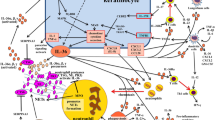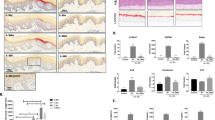Abstract
Interleukin-31 (IL-31) is a pro-inflammatory cytokine involved in skin inflammation and tumor progression. The IL-31 signaling cascade is initiated by its binding to two receptors, IL-31 receptor alpha (IL-31RA) and oncostatin M receptor subunit beta (OSMRβ). The previous study suggested that human IL-31 (hIL-31) directly interacts with IL-31RA and OSMRβ, independently, but the binding ability of hIL-31 to IL-31RA is stronger than to OSMRβ. In different to its human ortholog, feline IL-31 (fIL-31) has a higher binding affinity for feline OSMRβ. However, the binding pattern of canine IL-31 to its receptors remains to be elucidated. In this study, we purified the recombinant canine IL-31 (rcIL-31) protein and revealed its secondary structure to be mainly composed of alpha-helices. Moreover, in vitro studies show that rcIL-31 has the ability to induce the phosphorylation of signal transducer activator of transcription 3 (STAT3) and STAT5 in DH-82 cells. In the following, the binding efficacies of bioactive rcIL-31 for its individual receptor components have been measured using a flow cytometry assay. The result demonstrates that correctly refolded rcIL-31 binds independently with cIL-31RA and cOSMRβ which were expressed on the cell surface. Of note, rcIL-31 has a greater than tenfold higher affinity to OSMRβ than to IL-31RA. Additionally, we demonstrated that D1–D4, especially D4 of cOSMRβ, is crucial for its binding to cIL-31. Furthermore, this study proved that rcIL-31 has a high binding affinity to the soluble cOSMRβ with a KD value of 3.59 × 10–8 M. The results presented in the current study will have a significant implication in the development of drugs or antibodies against diseases induced by cIL-31 signaling.






Similar content being viewed by others
Data availability
The data that support the findings of this study are available from the corresponding author upon reasonable request.
References
Arita K, South AP, Hans-Filho G, Sakuma TH, Lai-Cheong J et al (2008) Oncostatin M receptor-beta mutations underlie familial primary localized cutaneous amyloidosis. Am J Hum Genet 82:73–80
Bammert GF, Dunham SA (2017) Interleukin-31 monoclonal antibody. European patent 3219729A1
Bammert GF, Gonzales AJ (2022) Antibodies to canine and feline Oncostatin M receptor beta and uses thereof. World Intellectual Property Organization 2022/086837A1
Bilsborough J, Leung DY, Maurer M, Howell M, Boguniewicz M et al (2006) IL-31 is associated with cutaneous lymphocyte antigen-positive skin homing T cells in patients with atopic dermatitis. J Allergy Clin Immunol 117:418–425
Caffarel MM, Coleman N (2014) Oncostatin M receptor is a novel therapeutic target in cervical squamous cell carcinoma. J Pathol 232:386–390
Chen J, Zheng Y, Wang L, Pang X, Gao F, **ao H, Huo N (2023) Expression purification and biological characterization of recombinant human interleukin-31 protein. Biotechnol Appl Biochem. https://doi.org/10.1002/bab.2470
Deller MC, Hudson KR, Ikemizu S, Bravo J, Jones EY, Heath JK (2000) Crystal structure and functional dissection of the cytostatic cytokine oncostatin M. Structure 8:863–874
Di Maira G, Foglia B, Napione L, Turato C, Maggiora M et al (2022) Oncostatin M is overexpressed in NASH-related hepatocellular carcinoma and promotes cancer cell invasiveness and angiogenesis. J Pathol 257:82–95
Di Salvo E, Allegra A, Casciaro M, Gangemi S (2021) IL-31, itch and hematological malignancies. Clin Mol Allergy 19:8
Diveu C, Lelievre E, Perret D, Lak-Hal AH, Froger J et al (2003) GPL, a novel cytokine receptor related to gp130 and leukemia inhibitory factor receptor. J Biol Chem 278:49850–49859
Diveu C, Lak-Hal A-H, Froger J, Ravon E, Grimaud L et al (2004) Predominant expression of the long isoform of GP130-like (GPL) receptor is required for interleukin-31 signaling. Eur Cytokine Netw 15:291–302
Dreuw A, Radtke S, Pflanz S, Lippok BE, Heinrich PC, Hermanns HM (2004) Characterization of the signaling capacities of the novel gp130-like cytokine receptor. J Biol Chem 279:36112–36120
Ferretti E, Corcione A, Pistoia V (2017) The IL-31/IL-31 receptor axis: general features and role in tumor microenvironment. J Leukoc Biol 102:711–717
Furue M, Yamamura K, Kido-Nakahara M, Nakahara T, Fukui Y (2018) Emerging role of interleukin-31 and interleukin-31 receptor in pruritus in atopic dermatitis. Allergy 73:29–36
Geethadevi A, Nair A, Parashar D, Ku Z, **ong W et al (2021) Oncostatin M receptor-targeted antibodies suppress STAT3 signaling and inhibit ovarian cancer growth. Can Res 81:5336–5352
Ghilardi N, Li J, Hongo JA, Yi S, Gurney A, de Sauvage FJ (2002) A novel type I cytokine receptor is expressed on monocytes, signals proliferation, and activates STAT-3 and STAT-5. J Biol Chem 277:16831–16836
Hwang SH, Yang Y, Jeong Y, Kim Y (2021) Ovalicin attenuates atopic dermatitis symptoms by inhibiting IL-31 signaling and intracellular calcium influx. J Biomed Res 35:448–458
Ip WK, Wong CK, Li ML, Li PW, Cheung PF, Lam CW (2007) Interleukin-31 induces cytokine and chemokine production from human bronchial epithelial cells through activation of mitogen-activated protein kinase signalling pathways: implications for the allergic response. Immunology 122:532–541
Jawa RS, Chattopadhyay S, Tracy E, Wang Y, Huntoon K et al (2008) Regulated expression of the IL-31 receptor in bronchial and alveolar epithelial cells, pulmonary fibroblasts, and pulmonary macrophages. J Interferon Cytokine Res 28:207–219
Jumper J, Evans R, Pritzel A, Green T, Figurnov M et al (2021) Highly accurate protein structure prediction with AlphaFold. Nature 596:583–589
Kabashima K, Irie H (2021) Interleukin-31 as a clinical target for pruritus treatment. Front Med (Lausanne) 8:638325
Kabashima K, Furue M, Hanifin JM, Pulka G, Wollenberg A et al (2018) Nemolizumab in patients with moderate-to-severe atopic dermatitis: randomized, phase II, long-term extension study. J Allergy Clin Immunol 142:1121–1130e7
Le Saux S, Rousseau F, Barbier F, Ravon E, Grimaud L et al (2010) Molecular dissection of human interleukin-31-mediated signal transduction through site-directed mutagenesis. J Biol Chem 285:3470–3477
Lee MY, Shin E, Kim H, Kwak IS, Choi Y (2018) Interleukin-31, interleukin-31RA, and OSMR expression levels in post-burn hypertrophic scars. J Pathol Transl Med 52:307–313
Lee BY, Hogg EKJ, Below CR, Kononov A, Blanco-Gomez A et al (2021) Heterocellular OSM-OSMR signalling reprograms fibroblasts to promote pancreatic cancer growth and metastasis. Nat Commun 12:7336
Lewis KE, Holdren MS, Maurer MF, Underwood S, Meengs B et al (2017) Interleukin (IL) 31 induces in cynomolgus monkeys a rapid and intense itch response that can be inhibited by an IL-31 neutralizing antibody. Acad Dermatol Venereol: JEADV 31:142–150
Marsella R, De Benedetto A (2017) Atopic dermatitis in animals and people: an update and comparative review. Vet Sci 4:37
Marsella R, Ahrens K, Wilkes R, Trujillo A, Dorr M (2020) Comparison of various treatment options for canine atopic dermatitis: a blinded, randomized, controlled study in a colony of research atopic beagle dogs. Vet Dermatol 31:284-e69
McCandless EE, Rugg CA, Fici GJ, Messamore JE, Aleo MM, Gonzales AJ (2014) Allergen-induced production of IL-31 by canine Th2 cells and identification of immune, skin, and neuronal target cells. Vet Immunol Immunopathol 157:42–8
McCollum S, Kalivas A, Kirkham M, Kunz K, Okojie J et al (2022) Oncostatin M receptor as a therapeutic target for radioimmune therapy in synovial sarcoma. Pharmaceuticals (Basel) 15:650
Medina-Cucurella AV, Bammert GF, Dunkle W, Javens C, Zhu Y et al (2020) Feline interleukin-31 shares overlap** epitopes with the oncostatin M receptor and IL-31RA. Biochemistry 59:2171–2181
Nemoto O, Furue M, Nakagawa H, Shiramoto M, Hanada R et al (2016) The first trial of CIM331, a humanized antihuman interleukin-31 receptor A antibody, in healthy volunteers and patients with atopic dermatitis to evaluate safety, tolerability and pharmacokinetics of a single dose in a randomized, double-blind, placebo-controlled study. Br J Dermatol 174:296–304
Olszewska B, Zawrocki A, Glen J, Lakomy J, Karczewska J et al (2022) Interleukin-31 is overexpressed in skin and serum in cutaneous T-cell lymphomas but does not correlate to pruritus. Postepy Dermatol Alergol 39:81–87
Putoczki TL, Dobson RC, Griffin MD (2014) The structure of human interleukin-11 reveals receptor-binding site features and structural differences from interleukin-6. Acta Crystallogr Sect D Biol Crystallogr 70:2277–2285
Reif A, Lam K, Weidler S, Lott M, Boos I et al (2021) Natural glycoforms of human Interleukin 6 show atypical plasma clearance. Angew Chem Int Ed 60:13380–13387
Richards CD, Gandhi R, Botelho F, Ho L, Paolini JF (2020) Oncostatin M induction of monocyte chemoattractant protein 1 is inhibited by anti-oncostatin M receptor beta monoclonal antibody KPL-716. Acta Derm Venereol 100:adv00197
Stander S, Yosipovitch G, Legat FJ, Lacour JP, Paul C et al (2020) Trial of Nemolizumab in moderate-to-severe prurigo nodularis. N Engl J Med 382:706–716
Tal Kan EF, Timaner M, Raviv Z, Orr S, Aronheim A, Shaked Y (2020) IL-31 induces antitumor immunity in breast carcinoma. J Immunother Cancer 8:e001010
West NR, Murphy LC, Watson PH (2012) Oncostatin M suppresses oestrogen receptor-alpha expression and is associated with poor outcome in human breast cancer. Endocr Relat Cancer 19:181–195
**ao H, Guo T, Yang M, Qi J, Huang C et al (2019) Light chain modulates heavy chain conformation to change protection profile of monoclonal antibodies against influenza A viruses. Cell Discov 5:21
Xu J, Zanvit P, Hu L, Tseng PY, Liu N et al (2020) The cytokine TGF-beta induces interleukin-31 expression from dermal dendritic cells to activate sensory neurons and stimulate wound itching. Immunity 53:371–383e5
Yang H, Chen W, Zhu R, Wang J, Meng J (2022) Critical players and therapeutic targets in chronic itch. Int J Mol Sci 23:9935
Yaseen B, Lopez H, Taki Z, Zafar S, Rosario H et al (2020) Interleukin-31 promotes pathogenic mechanisms underlying skin and lung fibrosis in scleroderma. Rheumatology (Oxf) 59:2625–2636
Yu Z, Li Z, Wang C, Pan T, Chang X et al (2019) Oncostatin M receptor, positively regulated by SP1, promotes gastric cancer growth and metastasis upon treatment with Oncostatin M. Gastric Cancer 22:955–66
Zhang X, Li J, Qin JJ, Cheng WL, Zhu X et al (2017) Oncostatin M receptor beta deficiency attenuates atherogenesis by inhibiting JAK2/STAT3 signaling in macrophages. J Lipid Res 58:895–906
Zheng Y, Fan Z, Zhang J, Chen J, Wang L et al (2022) Development and characterization of a novel mouse anti-canine oncostatin M receptor beta monoclonal antibody. Biochem Biophys Res Commun 614:114–19
Zhu YX, Li CH, Li G, Feng H, **a T et al (2020) LLGL1 regulates gemcitabine resistance by modulating the ERK-SP1-OSMR pathway in pancreatic ductal adenocarcinoma. Cell Mol Gastroenterol Hepatol 10:811–28
Acknowledgements
This work is supported by Tian** Synthetic Biotechnology Innovation Capacity Improvement Project (TSBICIP-KJGG-014 and TSBICIP-IJCP-001) and the National key research and development program of China (2020YFA0907104).
Author information
Authors and Affiliations
Corresponding author
Ethics declarations
Conflict of interest
The authors declare that there are no conflicts of interests in this manuscript.
Rights and permissions
Springer Nature or its licensor (e.g. a society or other partner) holds exclusive rights to this article under a publishing agreement with the author(s) or other rightsholder(s); author self-archiving of the accepted manuscript version of this article is solely governed by the terms of such publishing agreement and applicable law.
About this article
Cite this article
Zheng, Y., Zhang, J., Guo, T. et al. Canine interleukin-31 binds directly to OSMRβ with higher binding affinity than to IL-31RA. 3 Biotech 13, 302 (2023). https://doi.org/10.1007/s13205-023-03724-7
Received:
Accepted:
Published:
DOI: https://doi.org/10.1007/s13205-023-03724-7




